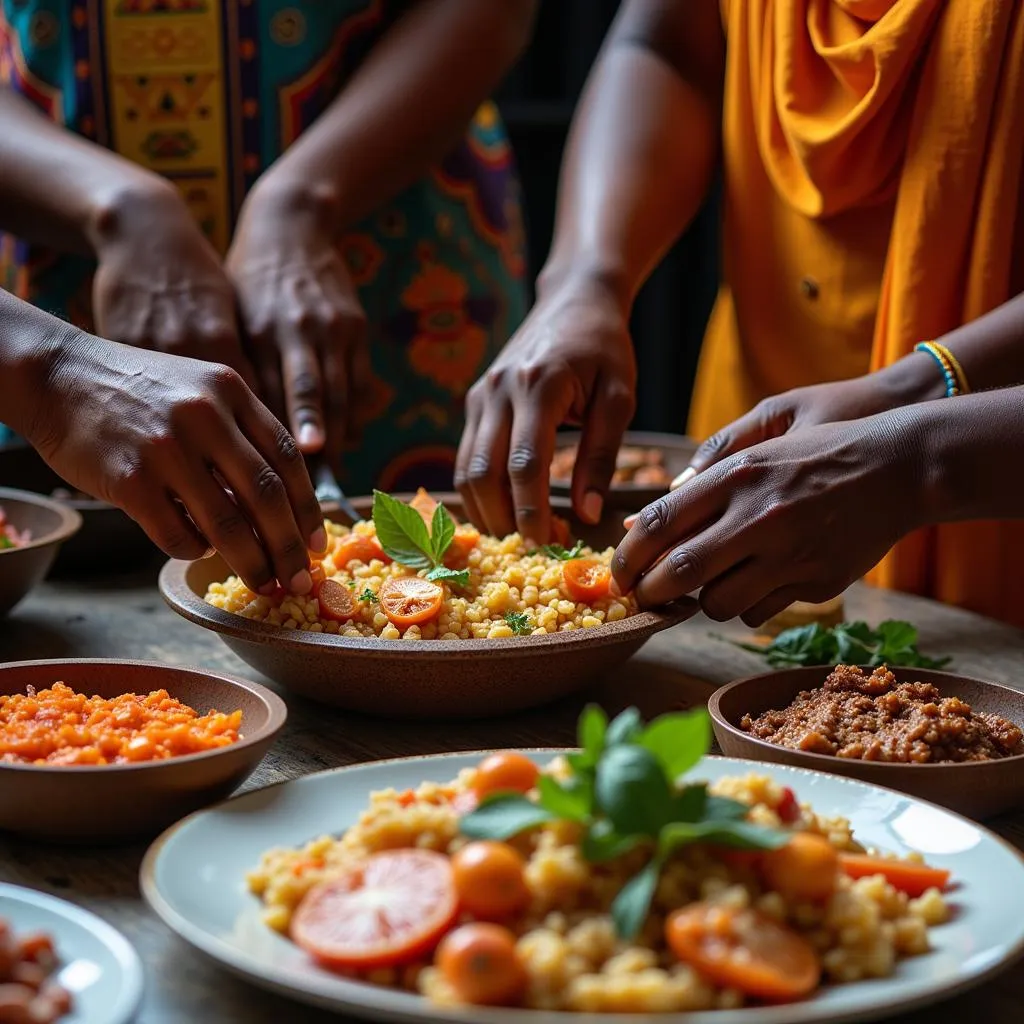The Art of African Eating with Hands: A Cultural Journey
In many African cultures, eating with hands is far more than a mere act of consuming food; it’s a deeply ingrained cultural practice that embodies tradition, community, and a profound connection to one’s heritage. This article delves into the fascinating world of African Eating With Hands, exploring its historical significance, social implications, and the sensory experience it offers.
A History Steeped in Tradition
 Family Eating Together
Family Eating Together
For centuries, eating with hands has been the norm across much of Africa. This tradition predates the arrival of cutlery and is rooted in a deep respect for the earth and its bounty. Using one’s hands to touch, feel, and savor food is seen as a way to connect directly with nature’s provisions. In many communities, it represents a sense of humility and gratitude for the nourishment provided.
The Social Tapestry of Communal Eating
African eating with hands is often a communal affair, symbolizing unity, sharing, and togetherness. Meals are typically served in a central location, with family and friends gathered around a single plate or bowl. This fosters a sense of community and encourages interaction as people break bread together, literally. The act of sharing food from the same source promotes a feeling of belonging and reinforces social bonds.
 Women Preparing Food Together
Women Preparing Food Together
A Sensory Symphony: Beyond Taste
Eating with hands engages all the senses, creating a more immersive and satisfying dining experience. The textures of the food become more pronounced, the aromas more potent, and the flavors more vibrant. It’s about appreciating the food in its entirety, from the moment it’s picked up to the last morsel savored. This tactile approach to eating enhances the enjoyment of the meal and allows for a deeper appreciation of the ingredients.
Etiquette and Customs: Navigating the Nuances
While eating with hands is widely practiced, there are specific customs and etiquette rules that vary across different regions and ethnic groups. These guidelines ensure respect and hygiene during communal meals. For instance, it’s customary to use the right hand for eating in many cultures, as the left hand is traditionally associated with hygiene practices. Additionally, there may be specific ways to scoop or pick up food that are considered polite and respectful.
 Elders Teaching Eating Etiquette
Elders Teaching Eating Etiquette
Beyond the Plate: The Cultural Significance
Eating with hands in Africa transcends the act of simply consuming food. It’s a celebration of heritage, a testament to cultural identity, and a way of life passed down through generations. It represents the strong sense of community, respect for tradition, and the deep connection to the land that are integral to many African cultures. In a rapidly changing world, this age-old tradition remains a powerful symbol of cultural pride and continuity.
Conclusion
African eating with hands is a captivating journey into the heart of African culture. It’s a practice that nourishes not just the body but also the soul, connecting people to their roots, their communities, and the essence of shared experience. More than just a meal, it’s a celebration of life, tradition, and the simple joys of connecting with food on a deeper level.
FAQs
1. Is it mandatory to eat with hands in Africa?
While eating with hands is deeply ingrained in many cultures, it’s not always mandatory. Many restaurants and urban settings offer cutlery as an alternative. It’s always respectful to follow the lead of your host or the local customs.
2. Are there any hygiene concerns associated with eating with hands?
Hygiene is paramount, and thorough handwashing is customary before and after meals. Additionally, food is often served in a way that minimizes direct hand contact, such as using utensils to serve portions or providing individual plates.
3. Which hand is considered appropriate for eating in most African cultures?
The right hand is generally considered the appropriate hand for eating in many African cultures, as the left hand is traditionally associated with hygiene practices.
4. Are there any specific foods that are typically eaten with hands?
Many staple foods, such as fufu, ugali, injera, and various stews, are traditionally eaten with hands. These foods are often served with sauces or stews that are best enjoyed by scooping and soaking with bread or starchy accompaniments.
5. Is it considered rude to refuse to eat with hands if offered?
It’s always polite to be respectful of local customs. While it’s not necessary to force yourself if you’re uncomfortable, expressing genuine appreciation for the tradition and politely explaining any cultural differences is always appreciated.
You might also be interested in:
Need help?
Contact us:
- Phone Number: +255768904061
- Email: kaka.mag@gmail.com
- Address: Mbarali DC Mawindi, Kangaga, Tanzania
Our customer service team is available 24/7 to assist you.



